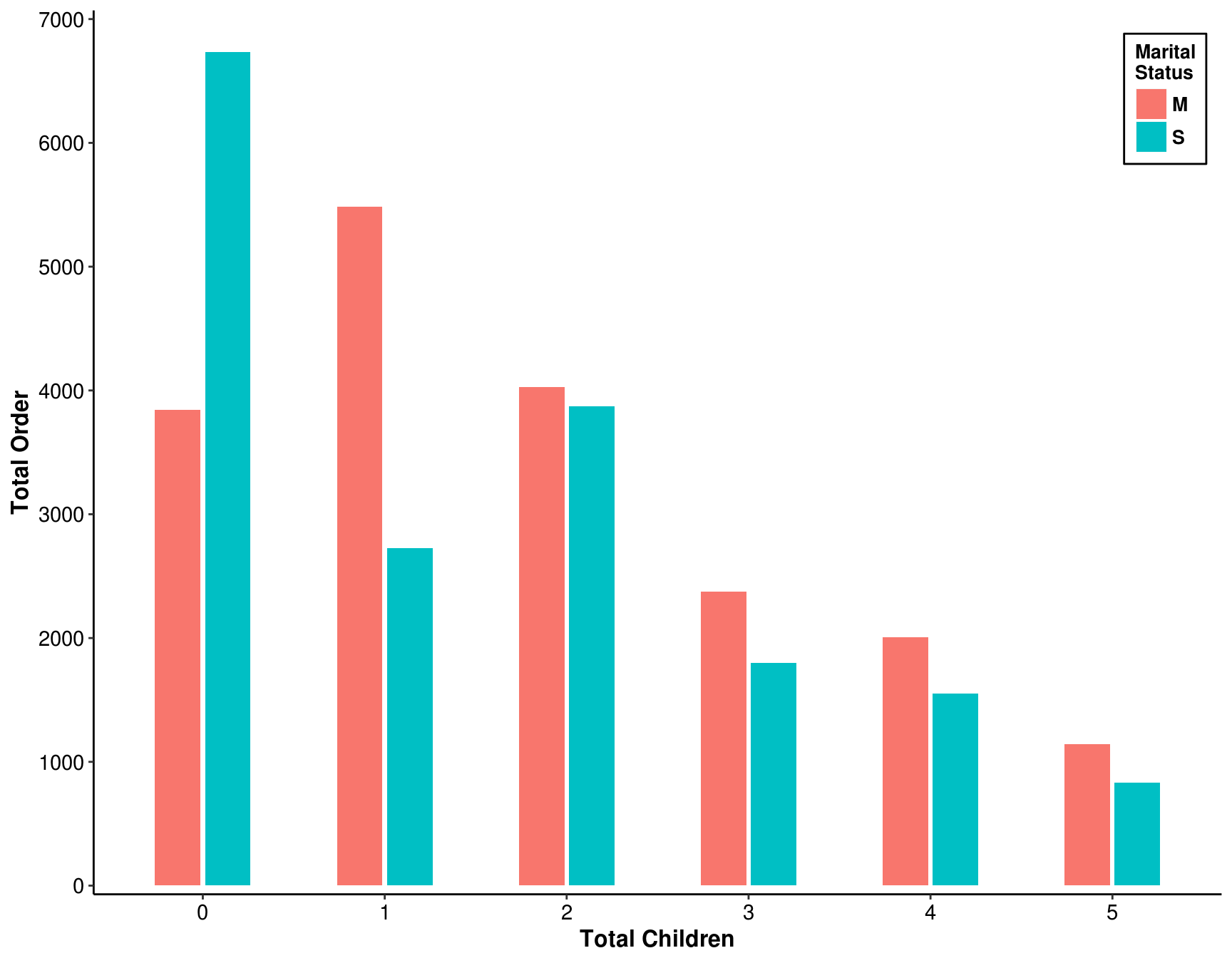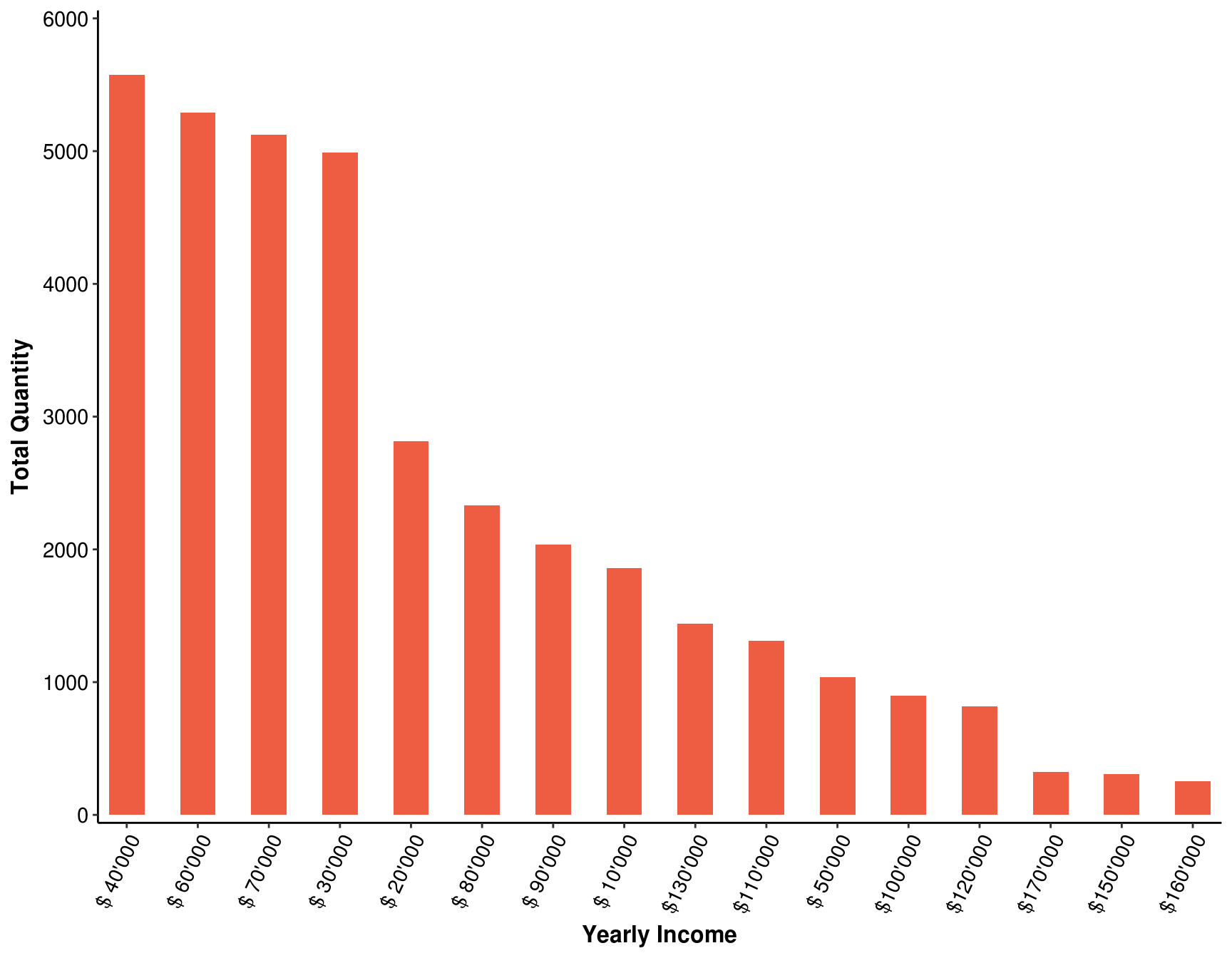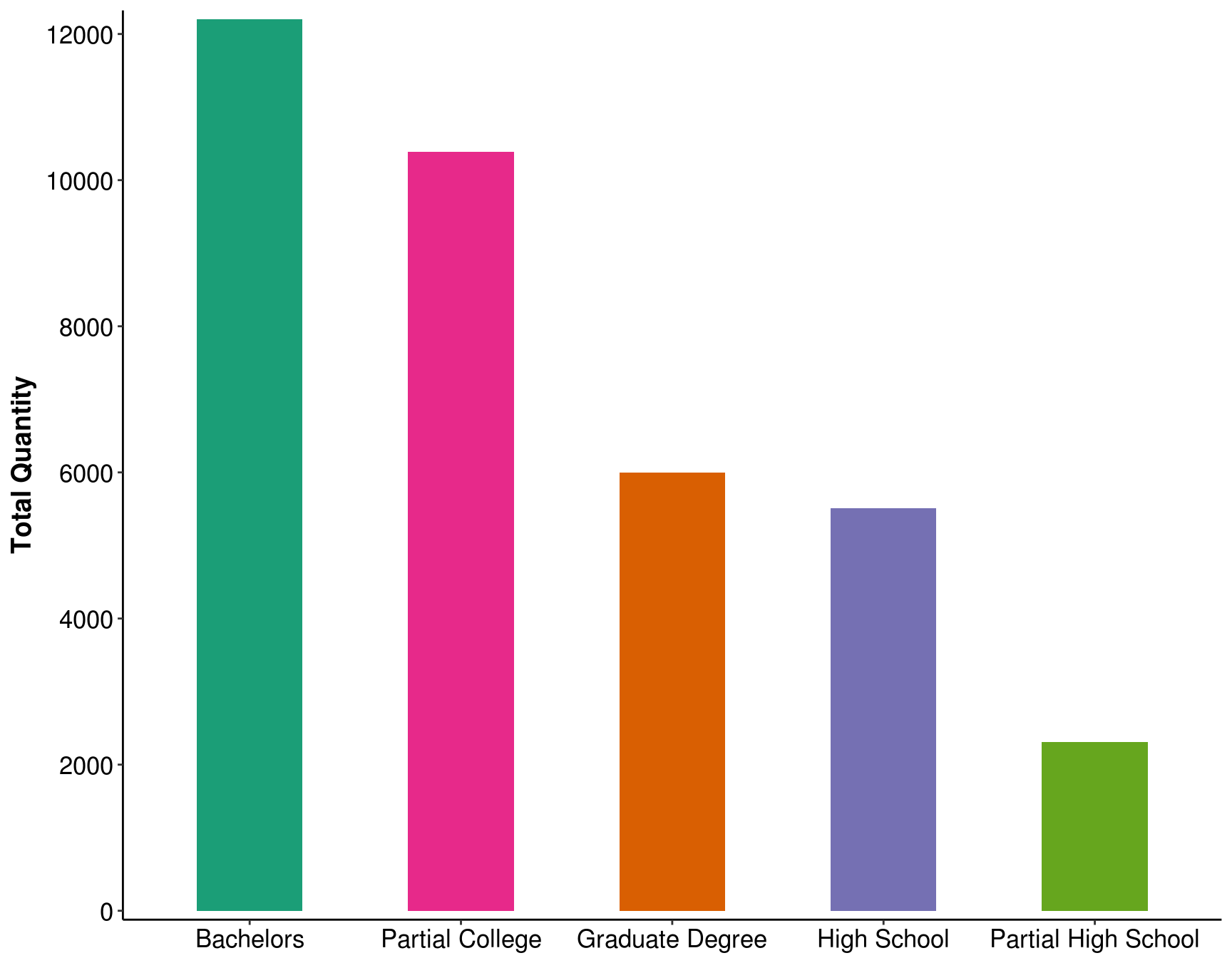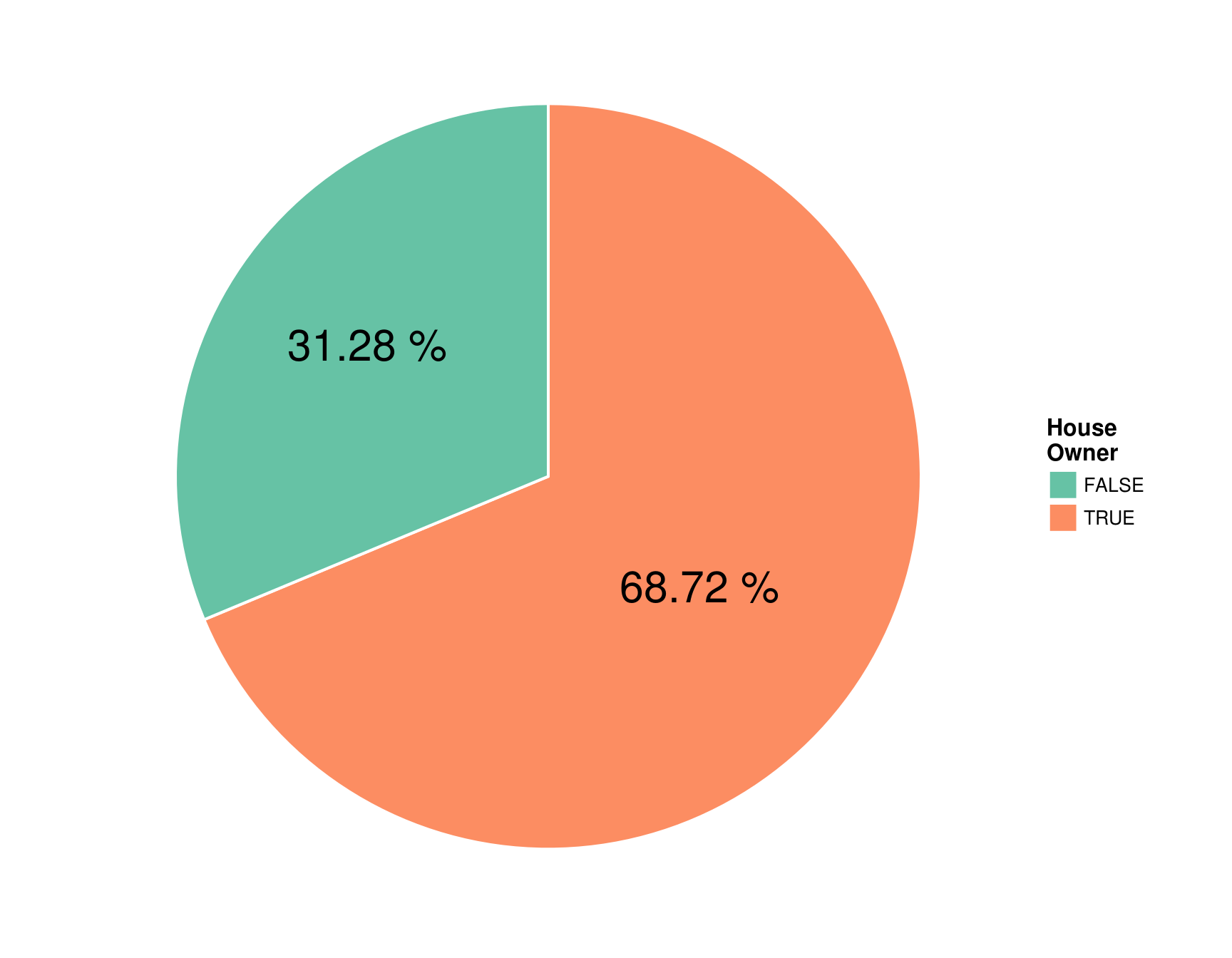Chapter 9 Join data from different sources
Scenario. Lastly, Lucy wants to have more information about the customer demographics in addition to the already available age and gender. Since your data has Customer ID for each row, you can “connect” these rows with your customer demographics database. Your customer demographics is stored in file “Customer_demographics.txt”.
Load necessary libraries
library(tidyverse)
library(RColorBrewer)
library(scales)Load data for Lab8:
my_data <- readRDS("./data/processing/data4week3.rds")
glimpse(my_data)## Observations: 113,036
## Variables: 19
## $ Date <dttm> 2013-11-26, 2015-11-26, 2014-03-23, 2016-0...
## $ Year <dbl> 2013, 2015, 2014, 2016, 2014, 2016, 2014, 2...
## $ Month <dbl> 11, 11, 3, 3, 5, 5, 5, 5, 2, 2, 7, 7, 7, 7,...
## $ `Customer ID` <dbl> 11019, 11019, 11039, 11039, 11046, 11046, 1...
## $ `Customer Age` <dbl> 19, 19, 49, 49, 47, 47, 47, 47, 35, 35, 32,...
## $ `Age Group` <chr> "Youth", "Youth", "Adults", "Adults", "Adul...
## $ `Customer Gender` <chr> "M", "M", "M", "M", "F", "F", "F", "F", "M"...
## $ Country <chr> "Canada", "Canada", "Australia", "Australia...
## $ State <chr> "British Columbia", "British Columbia", "Ne...
## $ `Product Category` <chr> "Accessories", "Accessories", "Accessories"...
## $ `Sub Category` <chr> "Bike Racks", "Bike Racks", "Bike Racks", "...
## $ Product <chr> "Hitch Rack - 4-Bike", "Hitch Rack - 4-Bike...
## $ `Frame Size` <dbl> NA, NA, NA, NA, NA, NA, NA, NA, NA, NA, NA,...
## $ `Order Quantity` <dbl> 8, 8, 23, 20, 4, 5, 4, 2, 22, 21, 8, 8, 7, ...
## $ `Unit Cost` <dbl> 45, 45, 45, 45, 45, 45, 45, 45, 45, 45, 45,...
## $ `Unit Price` <dbl> 120, 120, 120, 120, 120, 120, 120, 120, 120...
## $ Cost <dbl> 360, 360, 1035, 900, 180, 225, 180, 90, 990...
## $ Revenue <dbl> 950, 950, 2401, 2088, 418, 522, 379, 190, 2...
## $ Profit <dbl> 590, 590, 1366, 1188, 238, 297, 199, 100, 1...Customer demographics database:
add_data <- read.table("./data/raw/Customer_demographics.txt", sep = ",", header = T) %>%
as_data_frame()
glimpse(add_data)## Observations: 18,484
## Variables: 7
## $ ID <int> 1, 2, 3, 4, 5, 6, 7, 8, 9, 10, 11, 12, 13, 14...
## $ Customer.ID <int> 11000, 11001, 11002, 11003, 11004, 11005, 110...
## $ MaritalStatus <fctr> M, S, M, S, S, S, S, M, S, S, S, M, M, M, S,...
## $ YearlyIncome <int> 90000, 60000, 60000, 70000, 80000, 70000, 700...
## $ TotalChildren <int> 2, 3, 3, 0, 5, 0, 0, 3, 4, 0, 0, 4, 2, 2, 3, ...
## $ EnglishEducation <fctr> Bachelors, Bachelors, Bachelors, Bachelors, ...
## $ HouseOwnerFlag <lgl> TRUE, FALSE, TRUE, FALSE, TRUE, TRUE, TRUE, T...9.1 For those customers who bought bikes, what are the top three (bought the most quantity) customer profiles (marital status and number of children)?
ans_1 <- my_data %>%
select(`Customer ID`, `Order Quantity`, `Product Category`) %>%
left_join(add_data %>%
select(Customer.ID, MaritalStatus, TotalChildren), c("Customer ID" = "Customer.ID")) %>%
filter(`Product Category` == "Bikes") %>%
group_by(MaritalStatus, TotalChildren) %>%
summarise(`Total Order` = sum(`Order Quantity`)) %>%
arrange(desc(`Total Order`)) %>%
ungroup()
kable(ans_1)| MaritalStatus | TotalChildren | Total Order |
|---|---|---|
| S | 0 | 6733 |
| M | 1 | 5487 |
| M | 2 | 4029 |
| S | 2 | 3873 |
| M | 0 | 3845 |
| S | 1 | 2729 |
| M | 3 | 2375 |
| M | 4 | 2009 |
| S | 3 | 1802 |
| S | 4 | 1550 |
| M | 5 | 1145 |
| S | 5 | 834 |
ggplot(ans_1, aes(x = factor(TotalChildren), y = `Total Order`, fill = factor(MaritalStatus))) +
geom_bar(stat = "identity", position = position_dodge(0.55), width = 0.5) +
scale_y_continuous(breaks = seq(0, 7e3, 1e3), expand = c(0.01, 0),
limits = c(0, 7e3), oob = scales::squish) +
labs(x = "Total Children", fill = "Marital\nStatus") +
theme(plot.title = element_text(face = "bold", size = 14, hjust = 0.3),
panel.background = element_rect(fill = "white"),
legend.title = element_text(colour = "black", size = 10, face = "bold"),
legend.text = element_text(colour = "black", size = 10, face = "bold"),
legend.position = c(.95, .90),
legend.background = element_rect(color = "black"),
axis.line = element_line(colour = "black"),
axis.text = element_text(size = 11, colour = "black"),
axis.title = element_text(size = 12, face = "bold")) Answer: 1. Single without child 2. Married with one child 3. Married with two children
Answer: 1. Single without child 2. Married with one child 3. Married with two children
Now, replace the MaritalStatus and TotalChildren fields with the YearlyIncome field from the Customer_demographic table.
9.2 For those customers who bought bikes, what are the top three (bought the most quantity) income brackets? (Rank from highest to Lowest)
ans_2 <- my_data %>%
select(`Customer ID`, `Order Quantity`, `Product Category`) %>%
left_join(add_data %>%
select(Customer.ID, YearlyIncome), c("Customer ID" = "Customer.ID")) %>%
filter(`Product Category` == "Bikes") %>%
group_by(YearlyIncome)%>%
summarise(`Total Quantity` = sum(`Order Quantity`)) %>%
arrange(desc(`Total Quantity`)) %>%
ungroup()
kable(ans_2)| YearlyIncome | Total Quantity |
|---|---|
| 40000 | 5573 |
| 60000 | 5288 |
| 70000 | 5125 |
| 30000 | 4992 |
| 20000 | 2817 |
| 80000 | 2333 |
| 90000 | 2037 |
| 10000 | 1861 |
| 130000 | 1439 |
| 110000 | 1310 |
| 50000 | 1038 |
| 100000 | 898 |
| 120000 | 819 |
| 170000 | 324 |
| 150000 | 305 |
| 160000 | 252 |
`Yearly Income` <- reorder(ans_2$YearlyIncome, -ans_2$`Total Quantity`)
ggplot(ans_2, aes(x = `Yearly Income`, y = `Total Quantity`)) +
geom_bar(stat = "identity", width = 0.5, fill = "tomato2") +
scale_y_continuous(breaks = seq(0, 6e3, by = 1e3), expand = c(0.01, 0),
limits = c(0, 6e3), oob = scales::squish) +
scale_x_discrete(expand = c(0.01, 0), labels = paste0("$", prettyNum(`Yearly Income`, big.mark = "'"))) +
theme_classic() +
theme(axis.text.x = element_text(angle = 65, vjust = 1.0, hjust = 1.0),
axis.text = element_text(size = 11, colour = "black"),
axis.title = element_text(size = 12, face = "bold")) Answer:
Answer:
1. $40000 2. $60000
3. $70`000
Now, remove the YearlyIncome field and replace it with the EnglishEducation field from the add_data tibble.
9.3 For those customers who bought bikes, what are the top two (bought the most quantity) education levels?
ans_3 <- my_data %>%
select(`Customer ID`, `Order Quantity`, `Product Category`) %>%
left_join(add_data %>%
select(Customer.ID, EnglishEducation), c("Customer ID" = "Customer.ID")) %>%
filter(`Product Category` == "Bikes") %>%
group_by(EnglishEducation)%>%
summarise(`Total Quantity` = sum(`Order Quantity`)) %>%
arrange(desc(`Total Quantity`)) %>%
ungroup()
kable(ans_3)| EnglishEducation | Total Quantity |
|---|---|
| Bachelors | 12201 |
| Partial College | 10389 |
| Graduate Degree | 6002 |
| High School | 5505 |
| Partial High School | 2314 |
ggplot(ans_3, aes(x = reorder(EnglishEducation, -`Total Quantity`),
y = `Total Quantity`, fill = EnglishEducation)) +
geom_bar(stat = "identity", width = 0.5, show.legend = FALSE) +
scale_y_continuous(breaks = seq(0, 15e4, by = 2e3), expand = c(0.01, 0)) +
scale_fill_brewer(palette = "Dark2") +
theme_classic() +
theme(axis.title.x = element_blank(),
axis.text = element_text(size = 13, colour = "black"),
axis.title = element_text(size = 14, face = "bold")) Answer:
Answer:
1. Bachelors
2. Partial College
Lastly, remove the EnglishEducation field from the Rows and replace it with the HouseOwnerFlag field from the Customer_demographics table. Format the Sum of Order Quantity to show as Percentage of Grand Total with two decimal places.
9.4 What is the percentage of the customers who bought Bikes and are house owners?
ans_4 <- my_data %>%
select(`Customer ID`, `Order Quantity`, `Product Category`) %>%
left_join(add_data %>%
select(Customer.ID, HouseOwnerFlag), c("Customer ID" = "Customer.ID")) %>%
filter(`Product Category` == "Bikes") %>%
group_by(HouseOwnerFlag) %>%
summarise(Total = sum(`Order Quantity`)) %>%
mutate(`Grand Total, %` = formatC(Total / sum(Total) * 100, digits = 2, format = "f") %>%
as.numeric()) %>%
arrange(desc(`Grand Total, %`)) %>%
ungroup()
kable(ans_4)| HouseOwnerFlag | Total | Grand Total, % |
|---|---|---|
| TRUE | 25022 | 68.72 |
| FALSE | 11389 | 31.28 |
ggplot(ans_4, aes(x = "", y = Total / sum(Total), fill = HouseOwnerFlag)) +
geom_bar(width = 1, stat = "identity", colour = "white", size = 0.7) +
coord_polar(theta = "y") +
labs(fill = "House\nOwner", x = NULL, y = NULL) +
geom_text(aes(x = c(1.0, 1.1), y = c(0.35, 0.85), label = paste(`Grand Total, %`, "%")), size = 8) +
scale_fill_brewer(palette = "Set2") +
theme(panel.background = element_rect(fill = "white", color = "white"),
plot.title = element_text(face = "bold", size = 16, hjust = 0.6),
legend.title = element_text(face = "bold", colour = "black", size = 12),
legend.text = element_text(size = 10, color = "black"),
axis.text = element_blank(),
axis.ticks = element_blank()) Answer: 68.72%
Answer: 68.72%